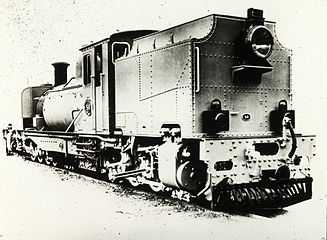South African Class NG G13 2-6-2+2-6-2
| South African Class NG G13 2-6-2+2-6-2 | |
|---|---|
|
NG G13 no. 49 at Sandstone Estates, near Ficksburg, 9 April 2006 | |
| Type and origin | |
| Power type | Steam |
| Designer |
Hannoversche Maschinenbau AG South African Railways |
| Builder | Hannoversche Maschinenbau AG |
| Serial number |
10549-10551 (58-60) 10598-10599 (50 & 49) 10629-10635 (77-83)[1] |
| Model | Class NG G13 |
| Build date | 1927-1928 |
| Total produced | 12 |
| Specifications | |
| Configuration | 2-6-2+2-6-2 "Double Prairie" Garratt |
| Gauge | 2 ft (610 mm) narrow gauge |
| Leading wheel diameter | 21 in (533 mm) |
| Driver diameter | 33 in (838 mm) |
| Trailing wheel diameter | 21 in (533 mm) |
| Minimum curve | 160 ft (48.768 m) |
| Wheelbase |
Total: 42 ft 9 in (13.030 m) Engine units: 6 ft 3 in (1.905 m) coupled 13 ft 2 in (4.013 m) total |
| Length | 48 ft 5.25 in (14.764 m) |
| Height | 10 ft 4 in (3.150 m) |
| Frame | Bar frame, 23 ft 9 in (7.239 m) between pivot centres |
| Axle load | 7.075 long tons (7.2 t) on 1st driver |
| Weight on drivers | 41.325 long tons (42.0 t) |
| Locomotive weight | 61.675 long tons (62.7 t) w/o |
| Fuel type | Coal |
| Fuel capacity | 4 long tons (4.1 t) |
| Water capacity |
1,285 imp gal (5,840 l) front 540 imp gal (2,500 l) rear |
| Boiler |
4 ft 7.75 in (1.416 m) inside diameter 9 ft 3.625 in (2.835 m) inside length 5 ft 5 in (1.651 m) pitch |
| Boiler pressure | 180 psi (1,240 kPa) |
| Firegrate area | 19.5 sq ft (1.812 m2) |
| Heating surface: – Tubes |
152 tubes 1.75 in (44.4 mm) diameter 15 tubes 5.5 in (140 mm) diameter 839 sq ft (77.946 m2) |
| – Firebox | 82.1 sq ft (7.627 m2) |
| – Total | 921.1 sq ft (85.573 m2) |
| Superheater area | 149 sq ft (13.843 m2) |
| Cylinders | Four |
| Cylinder size |
12 in (305 mm) bore 16 in (406 mm) stroke |
| Valve gear | Walschaerts |
| Performance figures | |
| Tractive effort | 18,850 lbf (84 kN) at 75% pressure |
| Career | |
| Operator(s) | South African Railways [2] |
| Class | Class NG G13 |
| Number in class | 12 |
| Number(s) | 49-50, 58-60, 77-83 |
| Delivered | 1927-1928 |
| First run | 1927 |
| Withdrawn | 1973 |
The South African Class NG G13 2-6-2+2-6-2 of 1927 is a South African steam locomotive from the South African Railways era.
In 1927 and 1928 the South African Railways placed twelve Class NG G13 Garratt articulated steam locomotives with a 2-6-2+2-6-2 Double Prairie type wheel arrangement in service on the Langkloof and Alfred County Railway narrow gauge lines.[3][4]
Manufacturer
In 1927 Hannoversche Maschinenbau AG (Hanomag), in consultation with the South African Railways (SAR), designed a locomotive which was to become the standard 2 feet (610 millimetres) narrow gauge Garratt locomotive in South Africa for the next forty years. It was greatly improved from the Class NG G11, with trailing wheels added to each engine unit, outside bar frames instead of plate frames, round top fireboxes instead of Belpaire fireboxes, and larger dimensions in most respects except the grate area.[4]
The initial order was for three Class NG G13 locomotives, numbered in the range from NG58 to NG60, that were delivered and placed in service in 1927. These locomotives were superheated and sported an extremely compact arrangement of Walschaerts valve gear and outside bar frames. The pilot wheels were arranged as conventional pony trucks, while the inner carrying wheels were built to the Gölsdorf system that allowed the axle some lateral movement.[3]
Performance trials of the Class NG G13 proved it to be both powerful and free steaming, despite having a smaller grate area than the predecessor Class NG G11. This resulted in an immediate order for another two locomotives, numbers NG49 and NG50, and even before these were delivered, another seven, numbered in the range from NG77 to NG83. The second and third orders were both delivered in 1928.[3]
Service
Natal
The first five locomotives, numbers NG49, NG50 and NG58 to NG60, were used almost exclusively on the narrow gauge lines in Natal. Some of these routes had curves of 45 metres (148 feet) and gradients of up to 3 in 100, but the Garratts were well suited to hauling the diverse freight traffic of pulpwood, sugar cane and bananas.
One of these lines, the 122 kilometres (76 miles) branch from Port Shepstone to Paddock via Izotsha, was eventually privatised as the Port Shepstone and Alfred County Railway (ACR) after the SAR ceased operations there in 1986. The ACR conducted both freight and tourist passenger operations, with the tourist train becoming known as the Banana Express.[5]
Cape Province
The third order of seven locomotives, numbers NG77 to NG83, initially all went to the Avontuur line where most of them remained for their entire service lives. In 1965 numbers NG77 and NG78 were exchanged for two Class NG G11 locomotives, numbers NG54 and NG55, from the Natal system. The Avontuur locomotives ended their service lives working out of Loerie, either hauling limestone trains to Van Stadens or doing duty on the Patensie branchline.[3]
The 283 kilometres (176 miles) Avontuur line stretches from Port Elizabeth to Avontuur through the Langkloof. The narrow gauge track enabled the trains to pick up fruit virtually directly from the Langkloof fruit farms and ship it directly, without reloading, to the ripening warehouses, distributors and ships at Port Elizabeth. The route became known as the Apple Express after the main crop it transported. The line also carried pulpwood, as well as limestone to supply the cement factories which were located on the route.[5]
Retirement
When the lower section of the Avontuur line was dieselised upon the arrival of the Class 91-000 diesel-electric locomotives in 1973, the Class NG G13 locomotives were all withdrawn from service. Beginning at about the same time, the Natal locomotives were also progressively withdrawn from service.[3]
Preservation
Since withdrawal from SAR service, some locomotives were sold into private hands, while others ended up in various degrees of preservation ranging across the spectrum from operational to plinthing to total abandonment. One known ex SAR Class NG G13 Garratt, number NG49 serving at the Sandstone Estates near Ficksburg, is being kept in excellent running order. Two were plinthed, number NG80 at Joubertina station and number NG81 at Patensie station.
The last known locations of all the Class NG G13 locomotives are shown in the table.[6]
Locations as at circa 2009
| Number |
Works No. |
Country |
Location |
Notes |
|---|---|---|---|---|
| NG49 | 10599/1928 | |
Sandstone Estates | Operational |
| NG50 | 10598/1928 | |
Hempstead, Texas | Under overhaul at the Hempstead and Northern Railroad in Hempstead, Texas |
| NG58 | 10549/1927 | |
SANRASM, Krugersdorp | First NG G13 delivered to SAR |
| NG59 | 10550/1927 | |
Scrapped | Wrecked after rolling over in an accident on the Weenen to Escourt line in the early 1980s |
| NG60 | 10551/1927 | |
Schinznach-Dorf | Stored operational |
| NG77 | 10629/1928 | |
Exmoor Steam Railway[7] | In store |
| NG78 | 10630/1928 | |
Emmerich | Privately owned by a Dr. Muhr |
| NG79 | 10631/1928 | |
Humewood Station | Under a roof but open to the elements[8] |
| NG80 | 10632/1928 | |
Joubertina station | Plinthed |
| NG81 | 10633/1928 | |
Patensie station | Plinthed |
| NG82 | 10634/1928 | |
Phyllis Rampton Trust | In store at a private site in Surrey. Previously resided at the Brecon Mountain Railway |
| NG83 | 10635/1928 | |
Berlin | German Museum of Technology |
Sides illustrated
The main picture and the following photographs offer views of both sides and ends of the Class NG G13 locomotive.
-

No. NG58, the first Class NG G13 delivered, c. 1927
-
.jpg)
Class NG G13 on a passenger train at Port Elizabeth, Cape Province, circa 1940
-

NG G13 no. NG81 plinthed at Patensie station, 8 April 1985
See also
- List of South African locomotive classes
- Narrow gauge locomotive numbering and classification
- South African Class NG G16 2-6-2+2-6-2
- South African locomotive history
- The 2-6-2+2-6-2 "Double Prairie"
- Two foot gauge railways in South Africa
References
|
- ↑ Hamilton, Gavin N., The Garratt Locomotive - Garratt Locomotives from Other Builders, retrieved 10 November 2012
- ↑ South African Railways and Harbours Locomotive Diagram Book, 2’0” & 3’6” Gauge Steam Locomotives, 15 August 1941, as amended
- ↑ 3.0 3.1 3.2 3.3 3.4 Paxton, Leith; Bourne, David (1985). Locomotives of the South African Railways (1st ed.). Cape Town: Struik. pp. 10–11, 107. ISBN 0869772112.
- ↑ 4.0 4.1 Durrant, A E (1989). Twilight of South African Steam (1st ed.). Newton Abbott, London: David & Charles. p. 124. ISBN 0715386387.
- ↑ 5.0 5.1 "South Africa Rail Offering". The New York Times. 1988-03-28. Retrieved 2010-05-23.
- ↑ Middleton, John N. (2002). Railways of Southern Africa Locomotive Guide - 2002 (as amended by Combined Amendment List 4, January 2009) (2nd, Dec 2002 ed.). Herts, England: Beyer-Garratt Publications. p. 31.
- ↑ Exmoor Steam Railway and its history
- ↑ "Humewood Road in Port Elizabeth". Steam Locomotives South Africa. 2009-08-23. Retrieved 2010-06-14.